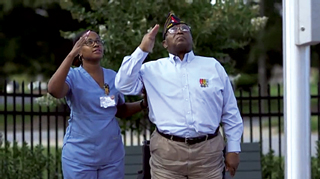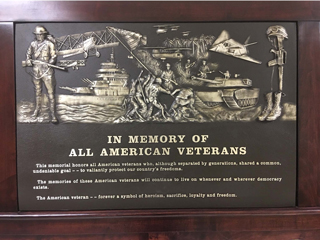
Procedural memory is a fascinating mechanism. Procedural memory is a construct of long-term memory and is the form of memory which “we learn by doing,” including singing, riding a bike, or playing the piano. They become automatic.
Therapists and caregivers often find individuals will demonstrate increased success for tasks when we integrate meaningful function.
Adding in procedural tasks, those which are ingrained deep in long term memory, within function can often result in outcomes surpassing our expectations.
For a recent veteran at Heritage Hall of Virginia Beach, VA, his procedural memory for saluting moved many caregivers during a recent ceremony around their flag.
His legs were weak, his balance unsteady.
His caregivers used a wheelchair to transport him outside to the flagpole that stands at the entrance of the facility.
When caregivers asked if he needed help standing, he politely said no.
You see, the task at hand was automatic.
The task of standing in salute.
• Turn your head and eyes toward the person or flag you are saluting.
• Raise your right hand until the tip of your forefinger touches the outer edge of your right eyebrow in one, smart motion without any preparatory movement.
• Your fingers are together, straight, and your thumb snug along the hand in line with the fingers.
• Your hand, wrist, and forearm are straight, forming a straight line from your elbow to your fingertips.
• Your upper arm (elbow to shoulder) is horizontal to the ground.
• When dropping the salute, bring your hand directly down to its natural position at your side, without slapping your leg or moving your hand out to the side.
• Any flourish in the salute is improper.
No amount of aging, or muscle wasting, or fear of falling could stand in his way.
Then straight as an arrow with pride in his eyes and love for his country in his heart, this veteran rose from his wheelchair and stood tall and strong in salute of the flag. (Shown here are Aaron Lily, right and nurse Monica Smith.)

Standing in salute is a way to show respect toward an officer, the flag or your country.
The salute isn’t simply an honor exchanged; it’s a privileged gesture of respect and trust among military members.
The way you salute says a lot about you as a soldier and the way Heritage Hall honors and cares for their veterans says a lot about it as a skilled nursing facility.
Heritage Hall of Virginia Beach is in the most-populated county in the country with Virginia Beach City, VA, having a total population over 450,000, 13.3% of which are veterans.
They not only serve veterans as residents, they also have a charge nurse and nurse aide who are veterans and continue to advertise job availability to local veterans organizations.
According to Administrator Ashley Jackson, “Serving veterans in our community is truly an honor. It is the definition of our mission statement: ‘Our Family Exist to Care For Yours.’ For so many years, these veterans and their families have sacrificed to keep us safe, and now my Heritage Hall family has the opportunity to give back and provide quality care services to them.”
As we look Saturday on Veterans Day to honor all of those who have served our country, let us remember the following, which is etched into the walls at Heritage Hall:
 “This memorial honors all American veterans who, although separated by generations, shared a common, undeniable goal — to valiantly protect our country’s freedoms. The memories of these America veterans will continue to live on whenever and wherever democracy exists. The American veteran — forever a symbol of heroism, sacrifice, loyalty and freedom.”
“This memorial honors all American veterans who, although separated by generations, shared a common, undeniable goal — to valiantly protect our country’s freedoms. The memories of these America veterans will continue to live on whenever and wherever democracy exists. The American veteran — forever a symbol of heroism, sacrifice, loyalty and freedom.”
Renee Kinder, MS, CCC-SLP, RAC-CT currently serves as Director of Clinical Education for Encore! Rehabilitation www.encorerehabilitation.com and acts as Gerontology Professional Development Manager for the American Speech Language Hearing Association (ASHA).




